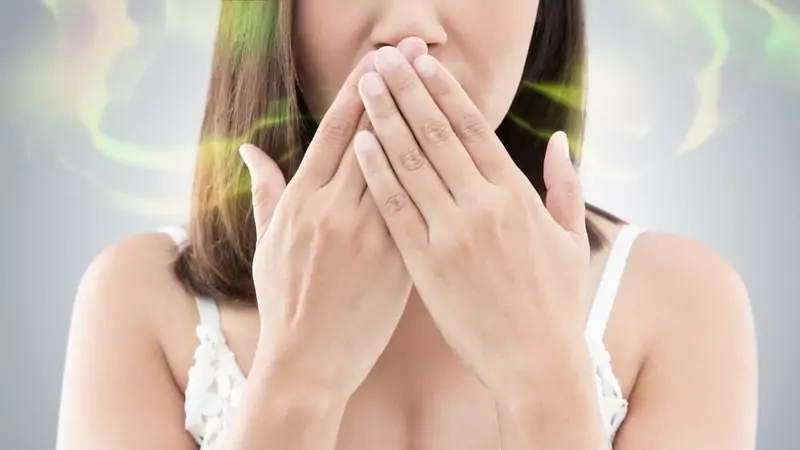Halitosis (Oral Malodor)
Oral malodor accounts for almost % 95 of all halitosis. Here, the cause of the odor is the tongue. In other words, the real smelling place in the mouth is the tongue. To be more precise, it is the back of the tongue. Even if there is a rotten tooth, tartar, bacterial plaque, inflamed gums, abscess, or infection in the mouth, the main source of odor is still the tongue. Because the surrounding inflamed tissue creates a source of bacteria for the back of the tongue and bad breath spreads from here.
A very small part of bad breath can be caused by decayed teeth, tartar, dental plaque, and other bacterial foci. However, it can happen if the surface area of these foci is large. Therefore, we can also call it tongue odor, since the dominant region that causes odor is the tongue.
The Main Cause of Halitosis
On the back of the tongue, there are deep indentations (crypt) and protruding (papillae) areas where saliva cannot easily wash off and bacteria can easily accommodate. Residues from the food we eat (especially proteins and amino acids) collect on the back of the tongue along with saliva. Bacteria coming from areas where bacteria are abundant in the mouth (for example, decayed teeth, inflamed gums, abscesses, dentures, and others) come to the back of the tongue. They meet with these food residues there. When bacteria break down the proteins here, especially the sulfurous ones, gases such as hydrogen sulfide, carbon sulfide, and dimethyl sulfide come out. These foul-smelling gases cause bad breath.
Characteristics of Mouth Odor
Bad breath is produced in our organism. In other words, the source of bad breath is not outside of the body. Accordingly, cigarette, onion, and garlic odors do not fit the definition of bad breath. Because we take them from outside, bad breath is produced within our organism. Although bad breath is produced in our organism, it is not an inflammation. So in these cases, there is no need to look for a source of inflammation.
Bad breath is not acute, it is a chronic condition. If there is an odor in the mouth that persists for more than 1-2 months, we call it bad breath. The individual himself may not feel this smell. Even if the individual is healthy, there may be bad breath. In this case, we cannot call it physiological or normal bad breath. Because if the person has bad breath that fits the definition of bad breath, or if there is a complaint about it, we cannot call it a ‘physiological condition’.
Symptoms and Diagnosis of Halitosis
People with mouth odor do not usually have the habit of brushing their teeth and tongue regularly. Therefore, there is often a yellow coating or impurities on the back of the tongue. In addition, there is a relationship between gingival bleeding and bad breath. Because gum bleeding is common in people with bad breath.
Halitosis Treatment
The treatment of bad breath starts with brushing the tongue together with the teeth. It is necessary to brush your teeth with a toothbrush every night before going to bed and after breakfast. In every brushing, it is necessary to brush the back of the tongue, either with a toothbrush or with a tongue-specific brush (eg, Peak Essentials Tung Brush or Dentek Orabrush Tongue Cleaner, etc.). However, those who complain of bad breath should go to the dentist and remove the places that constitute the source of bacteria in the mouth (rotten teeth, under bridges and veneers, inflamed gums, tartar, etc.).
If bad breath does not pass after doing all these, it will be necessary to continue the treatment for a few weeks with especially zinc-containing (eg, TheraBreath Plus Fresh Breath or Tom’s of Maine Natural Wicked Fresh, etc.), alcohol-free (eg, CloSYS Sensitive or Ultra Sensitive, etc.), and antiseptic (eg, Listerine Cool Mint, etc.) mouthwashes. If bad breath is caused by the back of the tongue, these methods will suffice to remove the odor. But, if the smell does not disappear despite these, the dentist will direct you to the relevant doctor.
References
American Dental Association:“Bad Breath: 6 Causes (and 6 Solutions)”
Harvard Medical School: Bad breath: What causes it and what to do about it”
Johns Hopkins Medicine: “Halitosis (Bad Breath)”
Mayo Clinic: Diseases and Conditions, “Bad Breath”
Oral Health Foundation: “Bad Breath”
PubMed: “Halitosis: a new definition and classification”

